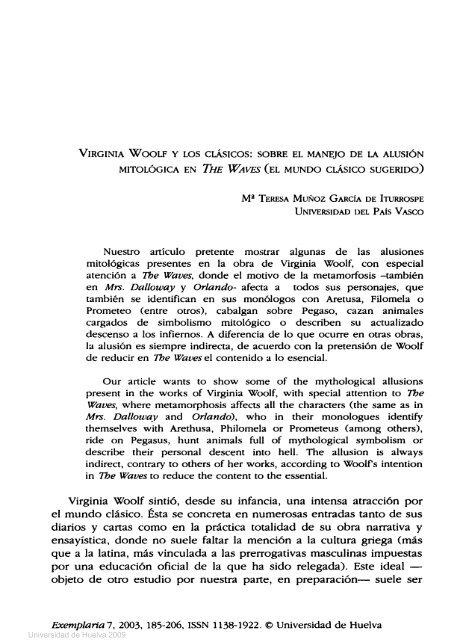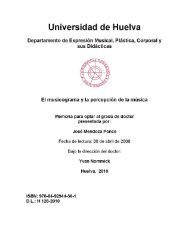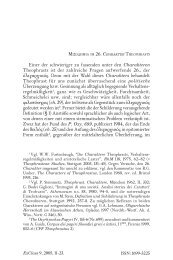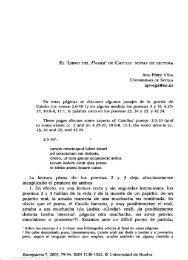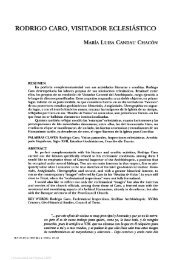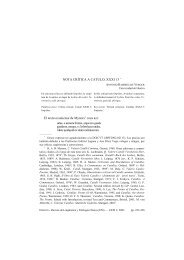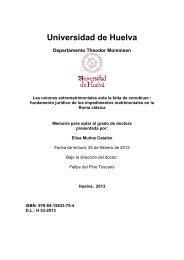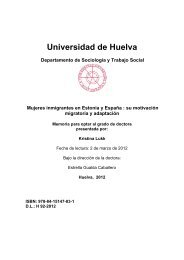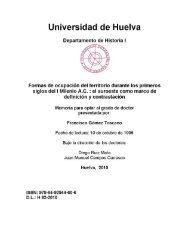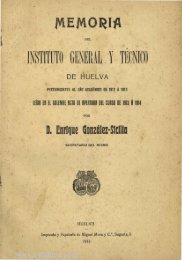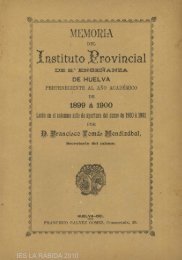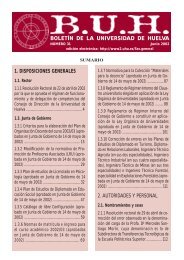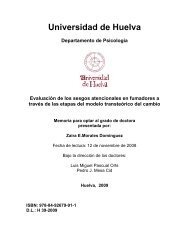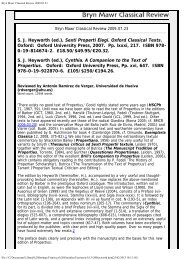Virginia Woolf sintió, desde su infancia, una intensa atracción por el ...
Virginia Woolf sintió, desde su infancia, una intensa atracción por el ...
Virginia Woolf sintió, desde su infancia, una intensa atracción por el ...
Create successful ePaper yourself
Turn your PDF publications into a flip-book with our unique Google optimized e-Paper software.
VIRGINIA WOOLF Y LOS CLÁSICOS: SOBRE EL MANEJO DE LA ALUSIÓN<br />
MITOLÓGICA EN THE WAVES (EL MUNDO CLÁSICO SUGERIDO)<br />
M ,2 TERESA MUÑOZ GARCIA DE ITURROSPE<br />
UNIVERSIDAD DEL PAÍS VASCO<br />
Nuestro artículo pretente mostrar alg<strong>una</strong>s de las alusiones<br />
mitológicas presentes en la obra de <strong>Virginia</strong> <strong>Woolf</strong>, con especial<br />
atención a The Waves, donde <strong>el</strong> motivo de la metamorfosis —también<br />
en Mrs. Dalloway y Orlando- afecta a todos <strong>su</strong>s personajes, que<br />
también se identifican en <strong>su</strong>s monólogos con Aretusa, Filom<strong>el</strong>a o<br />
Prometeo (entre otros), cabalgan sobre Pegaso, cazan animales<br />
cargados de simbolismo mitológico o describen <strong>su</strong> actualizado<br />
descenso a los infiernos. A diferencia de lo que ocurre en otras obras,<br />
la alusión es siempre indirecta, de acuerdo con la pretensión de <strong>Woolf</strong><br />
de reducir en The Waves <strong>el</strong> contenido a lo esencial.<br />
Our article wants to show some of the mythological allusions<br />
present in the works of <strong>Virginia</strong> <strong>Woolf</strong>, with special attention to The<br />
Waves, where metamorphosis affects all the characters (the same as in<br />
Mrs. Dalloway and Orlando), who in their monologues identify<br />
thems<strong>el</strong>ves with Arethusa, Philom<strong>el</strong>a or Prometeus (among others),<br />
ride on Pega<strong>su</strong>s, hunt animals full of mythological symbolism or<br />
describe their personal descent into h<strong>el</strong>l. The allusion is always<br />
indirect, contrary to others of her works, according to <strong>Woolf</strong>s intention<br />
in The Waves to reduce the content to the essential.<br />
<strong>Virginia</strong> <strong>Woolf</strong> <strong>sintió</strong>, <strong>desde</strong> <strong>su</strong> <strong>infancia</strong>, <strong>una</strong> <strong>intensa</strong> <strong>atracción</strong> <strong>por</strong><br />
<strong>el</strong> mundo clásico. Ésta se concreta en numerosas entradas tanto de <strong>su</strong>s<br />
diarios y cartas como en la práctica totalidad de <strong>su</strong> obra narrativa y<br />
ensayística, donde no <strong>su</strong><strong>el</strong>e faltar la mención a la cultura griega (más<br />
que a la latina, más vinculada a las prerrogativas masculinas impuestas<br />
<strong>por</strong> <strong>una</strong> educación oficial de la que ha sido r<strong>el</strong>egada). Este ideal —<br />
objeto de otro estudio <strong>por</strong> nuestra parte, en preparación— <strong>su</strong><strong>el</strong>e ser<br />
Exempla ría 7, 2003, 185-206, ISSN 1138-1922. © Universidad de Hu<strong>el</strong>va<br />
Universidad de Hu<strong>el</strong>va 2009
186 M TERESA MUÑOZ. GARCiA DE I71IRROSPE<br />
quebrantado <strong>por</strong> la actividad de profesores y académicos, <strong>por</strong> <strong>el</strong>la<br />
abiertamente despreciada.<br />
Así pues podría pensarse que en The Waves (1931), <strong>su</strong> obra más<br />
ambiciosa, la mención de la tradición clásica debería ser aún más<br />
vigorosa. Esto es verdad hasta cierto punto: <strong>el</strong> objeto d<strong>el</strong> presente<br />
estudio, las alusiones mitológicas, demostrará que si bien son<br />
numerosas, siempre <strong>su</strong>rgen a modo de insinuaciones v<strong>el</strong>adas. De<br />
hecho, no hay mención expresa más que a <strong>una</strong> breve serie de héroes<br />
griegos, a la que se debería unir <strong>el</strong> nombre d<strong>el</strong> héroe absoluto en The<br />
Waves, Percival: "Alcibiades, Ajax, Hector and Percival are also you' "<br />
(138). <strong>Woolf</strong> rinde así <strong>su</strong> particular tributo a la tradición, y da <strong>una</strong><br />
autoridad mayor a las actitudes y aseveraciones de los seis personajes<br />
que, con <strong>su</strong>s monólogos interiores, conforman <strong>el</strong> texto' .<br />
Es <strong>una</strong> perspectiva diferente de la que ofrecía en <strong>su</strong> primera nov<strong>el</strong>a<br />
"experimental", Jacob's Room (1922), donde <strong>el</strong> narrador <strong>su</strong>brayaba en<br />
varios momentos los p<strong>el</strong>igrosos efectos d<strong>el</strong> mito y de las historias,<br />
especialmente las procedentes de la tradición literaria clásica y los<br />
mitos griegos ("We have been brought up in an illusion", cf. Froula,<br />
1996: 281). No estará de más recordar que <strong>Virginia</strong> <strong>Woolf</strong>, aparte de <strong>su</strong><br />
esforzado interés <strong>por</strong> la literatura clásica, mantuvo <strong>una</strong> estrecha<br />
r<strong>el</strong>ación con la eminente arqueóloga e historiadora de la r<strong>el</strong>igión<br />
griega Jane Ellen Harrison (1850- 1928), discípula de Nietzsche y<br />
pionera de los estudios clásicos en la universidad inglesa .<br />
- METAMORFOSIS: LOS PERSONAJES Y EL MUNDO NATURAL.<br />
La metamorfosis planea sobre varias obras de <strong>Woolf</strong>, en especial<br />
Orlando, donde sirve para argumentar <strong>su</strong> defensa de la androginia, y<br />
Between the Acts, donde los principales personajes son comparados<br />
continuamente con animales, y donde tampoco faltan golondrinas,<br />
1 Más explícita era la identificación, dirigida asimismo directamente a Percival <strong>por</strong><br />
Neville en <strong>el</strong> borrador que muestra <strong>el</strong> Ms Berg Coll. VI, 5 de noviembre de 1930: "And<br />
then let us read Milton together, or Catullus: ... and the page is your voice made<br />
articulate: ... Alcibiades, Ajax, Hector are you" (Schlack, 1979: 180, n. 55).<br />
' Podemos encontrar un intento de explicación d<strong>el</strong> motivo d<strong>el</strong> uso de la mitología<br />
clásica renovado <strong>por</strong> parte de las mujeres escritoras, fundamentalmente d<strong>el</strong> siglo XX, en<br />
S<strong>el</strong>lers (2000: 30-34), que nos remite a Ostriker (1996: 317).<br />
Una biografía reciente de Harrison —hoy para muchos conocida <strong>por</strong> la mención<br />
explícita que de <strong>el</strong>la hace la propia <strong>Woolf</strong> en A Room of One's Own— es la de Beard<br />
(2000), que se puede completar con Torgovnick (1996). También ha sido estudiada <strong>su</strong><br />
r<strong>el</strong>ación con los principales modernistas (Phillips, 1991: 465-476; Carpentier, 1998 –que<br />
no hemos podido con<strong>su</strong>ltar-). Asimismo contamos con trabajos sobre la influencia<br />
directa de Harrison en la última obra de <strong>Woolf</strong> (Maika, 1987; Cuddy-Keane, 1990).<br />
Universidad de Hu<strong>el</strong>va 2009
VIRGINIA WOOLF Y LOS CLÁSICOS 187<br />
mariposas, árboles o nubes que interfieren en las actividades<br />
"humanas"; en Mrs Dalloway (1925) Sally Seton, que <strong>su</strong>fre <strong>una</strong><br />
evidente transformación de <strong>su</strong> juventud a <strong>su</strong> madurez, es identificada<br />
con <strong>una</strong> maga ("she was a magician!", 210), o <strong>el</strong> decadente Hugh es<br />
comparado <strong>por</strong> dos veces con un asno ("whimpering, sniv<strong>el</strong>ling old<br />
ass", 89; "was becoming an intolerable ass", 126), lo que los acerca a<br />
algunos de los personajes que pueblan El asno de oro de Apuleyo<br />
(obra conocida <strong>por</strong> <strong>Woolf</strong> a través de la traducción de J. Aldington,<br />
Londres 1904).<br />
En The Waves Louis —solitario, tímido, refugiado en la poesía<br />
clásica y en <strong>su</strong> madurez próspero hombre de negocios— se presenta<br />
en <strong>su</strong> primera intervención larga como un tallo con hojas conformadas<br />
<strong>por</strong> <strong>su</strong> p<strong>el</strong>o ("I am the stalk. [...] My hair is made of leaves. I am rooted<br />
to the middle of the earth. My body is a stalk", 7-8), evocación de<br />
alg<strong>una</strong> de las metamorfosis de Ovidio, como la de Dafne. Esta<br />
metamorfosis, sin duda la que cuenta con <strong>una</strong> mayor repercusión en<br />
todas las ramas d<strong>el</strong> arte europeo, ya había sido evocada brevemente<br />
en Orlando ("it looked as if the huntsmen were riding and Daphne<br />
flying", 107) y con más extensión y patetismo en Mrs. Dalloway, <strong>por</strong><br />
parte de un torturado Septimus Smith Warren ("And the leaves being<br />
connected by millions of fibres with his own body [...]; when the<br />
branch stretched he, too, made that statement", 24). Este texto es más<br />
amplio, y reproduce con llamativas metáforas <strong>una</strong> alucinación en la<br />
que reaparecen los gorriones, los mismos que en los d<strong>el</strong>irios de<br />
<strong>Virginia</strong> cantaban en griego: "The sparrows fluttering, rising and falling<br />
in jagged fountains were part of the pattern; the white and blue,<br />
barred with black branches" (24). Septimus se presenta como<br />
enraizado en <strong>el</strong> pavimento, plantado con un propósito que no es sino<br />
<strong>el</strong> de la búsqueda de la muerte ("Was he not weighted there, rooted to<br />
the pavement, for a purpose?", 16); y antes de <strong>su</strong> <strong>su</strong>icidio ve a <strong>su</strong><br />
esposa primero rodeada de pétalos y luego como un árbol florido a<br />
salvo, donde se esconde un temible legislador ("She was a flowering<br />
tree; and through her branches looked out the face of a lawgiver, who<br />
had reached a sanctuary where she feared no one", 162). En otro<br />
momento también advierte que le crecen flores rojas a través de <strong>su</strong><br />
carne, al tiempo que <strong>su</strong>s hojas de árbol le murmuran alrededor de la<br />
cabeza ("Red flowers grew through his flesh; their stiff leaves rustled<br />
by his head", 74-75), lo que le iguala con Adonis (cf. Wyatt, 1973:<br />
443).<br />
En <strong>el</strong> caso de Louis, la transformación no evita que reciba un beso<br />
de Jinny que hace que todo se conmocione. Además es a través de<br />
Jinny como conseguimos <strong>una</strong> confirmación de la casi realidad de la<br />
Universidad de Hu<strong>el</strong>va 2009
188 Ma TERESA MuÑoz GARCÍA DE ITURROSPE<br />
metamorfosis de Louis con imágenes igualmente vi<strong>su</strong>ales ("seeing you<br />
green as a bush, like a branch, very still, Louis, with your eyes fixed"),<br />
que explican que <strong>el</strong> beso no pretende sino la re<strong>su</strong>rrección de quien<br />
parece muerto (" 'Is he dead?', I thought, and kissed you...", 8).<br />
Neville, <strong>el</strong> más clasicista de los personajes (y volcado en los poetas<br />
latinos como Louis), identifica la muerte de Percival con un árbol<br />
infranqueable: "There stands the tree which I cannot pass" (114).<br />
Asimismo tampoco escapa a la metamorfosis, e incluso es consciente,<br />
en <strong>el</strong> comienzo de <strong>su</strong> edad madura, de cómo <strong>su</strong> árbol florece ("Now<br />
my tree flowers. My heart rises. All oppression is r<strong>el</strong>ieved. All<br />
impediment is removed. The reign of chaos is over", 92).<br />
De las mujeres, la metamorfosis más clara es la de Susan, que se<br />
convierte en piedra como Níobe (también madre <strong>por</strong> exc<strong>el</strong>encia) a la<br />
vista d<strong>el</strong> beso infantil de Jinny a Louis: "the y<strong>el</strong>low warmth in my side<br />
turned to stone when I saw Jinny kiss Louis" (9). Susan representa la<br />
fuerza de la naturaleza, la maternidad y los impulsos contrarrestados<br />
<strong>por</strong> un silencio buscado, y ésta es <strong>una</strong> de <strong>su</strong>s primeras reacciones.<br />
Rhoda también se com<strong>por</strong>ta como un pájaro <strong>desde</strong> <strong>su</strong> primera<br />
intervención, en la que imita <strong>el</strong> sonido de los pájaros: 'I hear a sound<br />
... cheep, chirp; cheep, chirp; going up and down 4 ' (5).<br />
Esta es razón<br />
para que parte de la crítica haya defendido que Rhoda está al margen<br />
d<strong>el</strong> lenguajes , privada de verba con <strong>el</strong> único mantenimiento de la vox,<br />
como tantos personajes femeninos en la obra ovidiana, o como <strong>su</strong><br />
amiga Jinny, nueva Filom<strong>el</strong>a —volveremos sobre este punto más<br />
ad<strong>el</strong>ante— que a veces sólo alcanza a emitir sonidos onomatopéyicos.<br />
Podemos mencionar <strong>una</strong> alusión más referida a la capacidad de<br />
metamorfosis, la que se refiere a <strong>una</strong> de las profesoras de las chicas,<br />
Mrs. Lambert, quien posee, según Rhoda, <strong>el</strong> poder de transformar los<br />
objetos, como la rana de los cuentos, <strong>una</strong> margarita o la misma carne<br />
que corta: "Wherever she goes, things are changed under her eyes"<br />
En la última página d<strong>el</strong> libro emplea dos veces este verbo: "sparrows on plane trees<br />
somewhere chirping"; "A bird chirps" (228). También es inint<strong>el</strong>igible la verborrea<br />
'griega' d<strong>el</strong> <strong>su</strong>puesto erudito Jacob Flanders, desconocedor de la historia antigua: "half<br />
of what he said was too dull to repeat; much inint<strong>el</strong>ligible" (Jacob's Room, 72).<br />
5 Minow-Pinkney (1987: 161, 183) también la excluye d<strong>el</strong> tiempo, como fuera de lo<br />
eminentemente simbólico; en contra de esta opinión. Lucenti (1998): "Rhoda, although<br />
seeming to be the absolute other of any system of meaning, including those of<br />
language, time, and ego, is not as exterior as she appears to be. Her exclusive<br />
orientation towards difference is evident in her repeated desire to be someone <strong>el</strong>se.<br />
This desire comp<strong>el</strong>s her own dissolution". El silencio aparece ligado a varias figuras<br />
femeninas de las metamorfosis ovidianas, como demuestran E. Caballero, M.E.<br />
Steinberg y M.A. Suárez (2001).<br />
Universidad de Hu<strong>el</strong>va 2009
VIRGINIA WOOLF Y LOS CLÁSICOS 189<br />
(32). Asimismo todo es solemne y pálido, en <strong>su</strong>ma clásico como <strong>una</strong><br />
estatua en <strong>una</strong> alameda ("All is solemn, all is pale where she stands,<br />
like a statue in a grove") al paso de la profesora, aunque <strong>el</strong> efecto<br />
parece exclusivamente momentáneo ("when she has gone is not the<br />
thing the same again?"). El hecho de que sea <strong>una</strong> mujer modifica <strong>el</strong><br />
habitual patrón patriarcal, frente a la autoridad masculina que, en la<br />
educación de los jóvenes, ejerce Mr. Crane (cf. "The professors, or<br />
patriarchs, as it might be more accurate to call them", A Room, 31), <strong>el</strong><br />
cual tiene, a los ojos de Neville, apariencia de estatua ("like some<br />
statue in a public garden", 22).<br />
- RHODA: ARETÜSA Y ARTEMISA.<br />
Como en Mrs. Dallowáy <strong>una</strong> vieja que canta frente a la estación de<br />
metro se metamorfosea en <strong>una</strong> también vieja fuente que brota de la<br />
tierra, '`the voice of no age or sex, the voice of an ancient spring<br />
spouting from the earth" (88), así en The Waves Rhoda —nombre<br />
griego— es en dos ocasiones identificada <strong>por</strong> Bernard con <strong>una</strong> ninfa<br />
de las fuentes, "nymph of the fountain always wet" (87, 199). Es, en<br />
<strong>su</strong>ma, <strong>una</strong> Aretusa (a la que no se nombra), ninfa de los bosques que<br />
se transformó en fuente para escapar de los abrazos de Alfeo, que<br />
huye d<strong>el</strong> amor y de los vínculos afectivos durante toda la obra.<br />
Únicamente llega a mantener <strong>una</strong> breve r<strong>el</strong>ación con Louis (<strong>el</strong> otro<br />
gran solitario), si bien <strong>el</strong>la le dejará pronto <strong>por</strong>que no quiere besos ("I<br />
left Louis; I feared embraces", 157).<br />
Esta metamorfosis fue recreada <strong>por</strong> Sh<strong>el</strong>ley -mol único poeta<br />
aludido <strong>por</strong> Rhoda indirectamente— en <strong>su</strong> poema "Arethusa"<br />
(interludio lírico d<strong>el</strong> drama Proserpine) y <strong>por</strong> Milton en "Lycidas"<br />
(Revard, 1995). También Castalia podría haber servido de inspiración<br />
para caracterizar a Rhoda, máxime cuando ya empleó este nombre<br />
para un personaje d<strong>el</strong> r<strong>el</strong>ato "A Societyb ", aunque debamos reconocer<br />
que la identificación de Castalia con <strong>una</strong> ninfa acuática es tardía, y en<br />
fuentes a las que difícilmente habría podido acceder nuestra autora.<br />
Más cerca, en <strong>una</strong> nov<strong>el</strong>a que influyó sin duda en <strong>Virginia</strong> (quien<br />
dedicó a <strong>su</strong> autor George Meredith un <strong>el</strong>ogioso ensayo) <strong>el</strong> noble<br />
Willoughby llama a <strong>su</strong> hija "nymph of the woods", después de señalar<br />
<strong>su</strong>s intentos de acercarla a los clásicos (más latín que griego) con<br />
reservas, al tratarse de <strong>una</strong> chica: "I have beaten some small stock of<br />
'' Castalia que, tras <strong>una</strong> visita a Oxford, comenta <strong>por</strong> ejemplo: "We agreed that it was<br />
the object of life to produce good people and good books" (Shorter Fiction, 128).<br />
Universidad de Hu<strong>el</strong>va 2009
190 Ma TERESA MUÑOZ GARCÍA DE ITURROSPE<br />
Latin into her head, and a note of Greek. She contains a savour of the<br />
classics. I hoped once ... But she is a girl. The nymph of woods is in<br />
her" (The Egoist, 244).<br />
Además de la identificación reiterada de Bernard, la misma Rhoda<br />
evidencia esta proximidad a Aretusa, y evoca varios versos de Sh<strong>el</strong>ley<br />
en que carga los términos de agua y profundidad que nos permiten<br />
ad<strong>el</strong>antarnos de alg<strong>una</strong> manera a esa caracterización. Así, <strong>por</strong> ejemplo,<br />
exclama "I will sit by the river's trembling edge and look at the water<br />
lilies [...] with moonlight beams of their own watery light. [...] There is<br />
some check in the flow of my being [...], Now the stream pours in a<br />
deep tide fertilising, ..." (41), comprensible ya que la fuente de Aretusa<br />
emergía de vez en cuando, en Ortigia. Pero <strong>desde</strong> <strong>su</strong> primer<br />
monólogo largo está asociada con <strong>el</strong> agua (la visión de los barcos) y la<br />
fuente ("let me pull mys<strong>el</strong>f out of these waters",19), con lo que<br />
Bernard no hace sino ayudarnos a la certidumbre de la identificación<br />
de Rhoda con Aretusa.<br />
Además de con <strong>el</strong> agua Rhoda se compara con la l<strong>una</strong> —"moon"<br />
aparece quince veces en <strong>el</strong> texto, "moonlight" siete—: "I am like the<br />
foam that races over the beach or the moonlight that falls arrowlike<br />
here on a tin can" (98); "moonlight falling upon some high peak<br />
where the eagle soars'" (109). Es la comparación a través de la que<br />
también la podemos asociar con Artemisa/Diana, diosa de la castidad,<br />
de la caza y de la luz l<strong>una</strong>r, de la que es seguidora la misma Aretusa.<br />
Artemisa nace justamente en la misma isla de Ortigia y se caracteriza<br />
<strong>por</strong> recorrer con ligereza bosques, s<strong>el</strong>vas y montes, antítesis de<br />
Afrodita/Venus (recordemos que Rhoda rechaza <strong>el</strong> amor físico). El<br />
paisaje bañado <strong>por</strong> la l<strong>una</strong> d<strong>el</strong> texto que acabamos de señalar había<br />
sido evocado <strong>por</strong> Keats, otro poeta romántico admirado <strong>por</strong> <strong>Virginia</strong><br />
<strong>Woolf</strong>, en Endymion (1818). Y la espuma blanca nos acerca a la visión<br />
de la mujer que ya presentaba <strong>Woolf</strong> en A Room of One's Ou'n, como<br />
"a vess<strong>el</strong> in which all sorts of spirits and forces are coursing and<br />
flashing perpetually" (40). En la isla las aguas de la fuente de Artemisa<br />
se pueden mezclar con las d<strong>el</strong> mar, refugio para la diosa y para <strong>su</strong>s<br />
ninfas.<br />
Artemisa —que, evidentemente, no aparece en la versión definitiva<br />
de The Waves— es mencionada expresamente en <strong>el</strong> primer borrador<br />
<strong>por</strong> dos ocasiones: "a statue of [Aphro] Artemis in the glade", "the<br />
pillar of Artemis among the dark green laur<strong>el</strong>s" (Graham, Draft 1: 202).<br />
Incluso menciona en <strong>su</strong> ofrenda <strong>desde</strong> la colina <strong>una</strong> flor con color de luz de l<strong>una</strong>,<br />
the moonlight-coloured May" (158). que no es sino la flor d<strong>el</strong> espino albar.<br />
Universidad de Hu<strong>el</strong>va 2009
VIRGINIA WOOLF Y LOS Ct.Ásicos 191<br />
Más ad<strong>el</strong>ante, <strong>el</strong> mismo borrador también incluía <strong>una</strong> referencia más<br />
concreta de la estatua <strong>por</strong> la que <strong>su</strong>spira Rhoda, que sería la de<br />
Artemisa, y en <strong>una</strong> isla griega donde no puede faltar <strong>el</strong> pequeño<br />
bosque: "a grove in a Greek island" (Graham, Draft 1: 297). En la<br />
redacción definitiva sabemos que Rhoda, en la noche, se acerca a lo<br />
que parece un templo en ruinas donde arroja <strong>su</strong> ramillete, cerca de las<br />
olas que rompen ("here and there a marble pillar", 157). Rhoda<br />
también ve, a la luz de la l<strong>una</strong> (que la acerca otra vez a Artemisa) "two<br />
people without faces, leaning like statues against the sky", símbolo<br />
aquí de un mundo que difícilmente cambia ("a world immune from<br />
change", 79), y que también hemos encontrado en <strong>una</strong> entrada de los<br />
diarios (Diary Iii 300, 9 de abril 1930, "statues against the sky").<br />
Aquí la representación recuerda episodios de Dante, como <strong>el</strong> de la<br />
visión de la encantadora Matilde cogiendo flores en la cumbre d<strong>el</strong><br />
monte Purgatorio, en un idílico paisaje primaveral, la cual es<br />
comparada en un momento (Purgat. 28, 49-51; cf. Ovid. Met. V 385-<br />
408) con Proserpina ("Tu mi fai rimembrar dove e qua! era /<br />
Proserpina n<strong>el</strong> tempo che perdette / la madre lei, ed <strong>el</strong>la primavera$ ").<br />
Sólo imaginándose un paraje clásico es como Rhoda se puede sentir<br />
segura: lo clásico significa, pues, un alejamiento de la sociedad en la<br />
que se siente desplazada.<br />
Este sentimiento de arrinconamiento acerca al torturado personaje<br />
que representa Rhoda a la l<strong>una</strong>, ligada a la persecución —tan<br />
frecuentemente vinculada a la metamorfosis— de un tigre y a la<br />
presencia de <strong>una</strong> golondrina, inevitablemente nos hace recordar la<br />
metamorfosis de Procne: "I shall (..) look at the moon. (...) The door<br />
opens; the tiger leaps. (...) Let me visit furtiv<strong>el</strong>y the trea<strong>su</strong>res I have<br />
laid apart. Pools lie on the other side of the world reflecting marble<br />
columns. The swallow dips her wing in dark pools [...] I who long for<br />
marble columns and pools on the other side of the world where the<br />
swallow dips her wings" (78); poco más tarde la visión se repite, con<br />
términos cercanos: "The tiger leap, and the swallow dipped her wings<br />
in dark pool on the other side of the world" (95); Rhoda puede ser la<br />
golondrina que se a<strong>su</strong>sta ante <strong>el</strong> reiterado ataque d<strong>el</strong> tigre: "The door<br />
opens and the tiger leaps" (97); finalmente, <strong>una</strong> evocación más d<strong>el</strong><br />
" La traducción inglesa de Sh<strong>el</strong>ley (¿<strong>una</strong> vez más intermedio para nuestra autora?) <strong>su</strong>ma<br />
<strong>el</strong> espíritu de Dante al de Milton: - ...like Proserpine, in Enna's glen, / Thou seemest to<br />
my fancy, singing here / And gathering flowers, as that fair maiden when / She lost the<br />
spring, and Ceres her, more dear" (vv. 48-51, "Matilda Gathering Flowers"). Cf. Webb,<br />
1996: 313-326.<br />
Universidad de Hu<strong>el</strong>va 2009
192 Ma TERESA MUÑOZ GARCIA DE ITURROSPE<br />
gorrión —que además se aúna con la noche—, también nos llega<br />
<strong>desde</strong> <strong>el</strong> monólogo de Rhoda, ya acercándose a <strong>su</strong> final trágico: "The<br />
swallow dips her wings in midnight pools" (171).<br />
- RHODA Y LOS RITUALES DE FERTILIDAD.<br />
Rhoda sirve asimismo, <strong>desde</strong> <strong>su</strong> actitud solitaria y virginal, como<br />
puente a la fertilidad, cuyos ritos son centrales en la mitología clásica.<br />
Así, a través de <strong>el</strong>la nos acercamos a <strong>una</strong> <strong>su</strong>erte de reencarnación de<br />
Atis, que <strong>Virginia</strong> <strong>Woolf</strong> despacha con inusitada rapidez en diversas<br />
imágenes, de las que destacan las violetas que florecen —de la sangre<br />
de Atis— y que se dispone a recoger Rhoda para ofrecérs<strong>el</strong>as a<br />
Percival ya muerto. La ofrenda se realiza sobre un <strong>su</strong><strong>el</strong>o desnudo, "On<br />
the bare ground I will pick violets and bind them together and offer<br />
them to Percival, something given him by me" (120), y <strong>su</strong>giere los<br />
aspectos más destructivos, y al mismo tiempo creativos, de las<br />
r<strong>el</strong>aciones entre hombres y mujeres, que encuentran <strong>su</strong>s corr<strong>el</strong>atos en<br />
los seis personajes (cf. Richter, 1978: 126).<br />
<strong>Woolf</strong> amplía <strong>el</strong> texto de Sh<strong>el</strong>ley en que se basaba en las frases<br />
anteriores ("wild roses, and ivy serpentine" y la misma pregunta de a<br />
quién ofrecerlas "Oh! To whom?" se leen en <strong>su</strong> poema "The Question",<br />
vv. 21 y 40v). Esta ofrenda sirve asimismo para que Neville termine <strong>el</strong><br />
largo monólogo —solo entre dos interludios poéticos— <strong>su</strong>scitado <strong>por</strong><br />
la noticia de la muerte de Percival: "...I throw my violets, my offering<br />
to Percival" (124).<br />
Louis —otra vez hay reciprocidad de los pensamientos con otro<br />
personaje— nos explica que las violetas representan la muerte, "Death<br />
is woven in with the violets" (106), y en la procesión que describe<br />
Rhoda se arrojan violetas (105), <strong>por</strong> lo que no puede extrañar que sea<br />
<strong>el</strong> héroe muerto, Percival, <strong>el</strong> último destinatario de <strong>una</strong> ofrenda que,<br />
en un momento anterior, Rhoda pensaba dejar sobre la brillante mesa<br />
de, quizá, <strong>su</strong> admirada profesora Miss Lambert ("I will clasp them in<br />
my hands and lay them on the desk's shiny <strong>su</strong>rface", 41).<br />
El complejo entramado simbólico de <strong>Woolf</strong> en esta obra se<br />
demuestra con la vinculación amorosa d<strong>el</strong> personaje de Neville,<br />
admirador y émulo de Catulo, con Percival, dado que Catulo es autor<br />
d<strong>el</strong> más famoso poema dedicado a Atis (carm. 63). Catulo es admirado<br />
<strong>por</strong> <strong>Woolf</strong> (que disponía en <strong>su</strong> biblioteca de <strong>su</strong>s poemas), que hace<br />
Goldman (1998: 195-196) va más allá, y considera las diferencias entre Sh<strong>el</strong>ley y <strong>Woolf</strong><br />
un reflejo de las tendencias feministas de esta última, para quien los colores se<br />
asociarían expresamente con la profesora.<br />
Universidad de Hu<strong>el</strong>va 2009
VIRGINIA WOOLF Y LOS CLÁSICOS 193<br />
leer uno de <strong>su</strong>s más conocidos versos —nox est perpetua <strong>una</strong><br />
dormienda— a North, personaje de The Years, se trata, como no podía<br />
ser menos, de un pequeño volumen (la autora gusta de dar detalles<br />
"materiales" de los libros que leen <strong>su</strong>s personajes), aunque en la<br />
versión definitiva la lectura sea de Herrick y Campion (Leaska, 1977:<br />
217). Como en <strong>el</strong> caso de Ovidio y Sh<strong>el</strong>ley en The Waves, aquí se<br />
confirma que <strong>Virginia</strong> <strong>Woolf</strong> prefiere la fuente intermedia: son célebres<br />
tanto <strong>el</strong> poema "To Sappho" en que Herrick parafrasea <strong>el</strong> mismo<br />
carmen 5 ( "Let us take time and play, / Love, and live here while we<br />
may;...") como la versión de Campion ("My Sweetest Lesbia, let us liue<br />
and loue, / [...] Then must we sleepe one euer-during night", abriendo<br />
A Booke of Ayres).<br />
En cuanto a las posibles fuentes de las que bebe la autora, aparte<br />
de Sh<strong>el</strong>ley y Catulo, no hay que olvidar que <strong>el</strong> ritual de fertilidad había<br />
sido ampliamente desarrollado <strong>por</strong> Frazer en The Golden Bough en los<br />
capítulos dedicados a Adonis, Atis y Osiris, obra que influye<br />
abiertamente en referencias a ritos en The Waste Land de Eliot, <strong>por</strong><br />
ejemplo (ampliación en Medcalf, 1988: 239-241), donde se ha<br />
entendido <strong>el</strong> uso de la golondrina como símbolo de primavera y<br />
música, frente a la vulgaridad y esterilidad sexual de las dos primeras<br />
partes (Feder, 1973: 231). Y este mismo poema de Eliot se evoca con<br />
más claridad en M. Dalloway, cuando Septimus Warren Smith se<br />
identifica con un marinero ahogado, símbolo de la fertilidad asociada a<br />
la muerte, también en The Waste Land (47, "the drowned Phoenician<br />
Sailor", es decir Flebas, mencionado expresamente en dos ocasiones<br />
más, vv. 312 y 321, "Phlebas the Phoenician", y que ha sido<br />
r<strong>el</strong>acionado con Jean Verdenal amigo de Eliot muerto en 1915 durante<br />
la Primera Guerra Mundial, como Evans, <strong>el</strong> amigo que se aparece a<br />
Septimus): la inmersión d<strong>el</strong> dios en <strong>el</strong> agua asegura la lluvia para las<br />
cosechas. La esposa de Septimus confirma esta vinculación a <strong>su</strong><br />
muerte ("rain falling, [...] stirrings among dry corn", 165), al tiempo que<br />
se ve envu<strong>el</strong>ta <strong>por</strong> <strong>el</strong> océano, imagen de la vida universal ("the caress<br />
of the sea ... hollowing them in its arched sh<strong>el</strong>l"), <strong>el</strong> mismo día en que<br />
había pensado en la posibilidad de tener hijos con él.<br />
- SUSAN: LA MAGNA MATER Y EL PRIMITIVISMO.<br />
No re<strong>su</strong>lta difícil destacar d<strong>el</strong> personaje de Susan <strong>su</strong> decisión de ser<br />
la representación de la Gran Madre, divinidad de la naturaleza —<br />
vinculada en alg<strong>una</strong>s versiones a Atis, con todo no debe considerarse<br />
sólo dentro de la mitología clásica—, que antes de decidir<br />
voluntariamente quedar r<strong>el</strong>egada al silencio y la maternidad muestra<br />
Universidad de Hu<strong>el</strong>va 2009
194 M TERESA MUÑoz GARCÍA DE ITURROSPE<br />
abiertamente y con pasión todo <strong>su</strong> primitivismo, con <strong>el</strong>ementos que a<br />
<strong>Virginia</strong> le pueden haber inspirado las lecturas de <strong>su</strong> admirada Jane<br />
Harrison. La tierra, la fertilidad y la muerte estaban estrechamente<br />
vinculadas en la r<strong>el</strong>igión de los griegos, bien conocida <strong>por</strong> <strong>Woolf</strong> a<br />
través de <strong>su</strong>s lecturas juveniles, y afianzada gracias a <strong>su</strong> amistad con la<br />
eminente profesora Harrison. Para denotar la fertilidad y <strong>el</strong><br />
contrasentido de la guerra encontramos a Ceres en Mrs Dalloway, a<br />
través de la cual dest<strong>el</strong>la, en <strong>una</strong> magnífica metáfora, <strong>el</strong> doble desastre<br />
de la guerra, que "hizo añicos <strong>una</strong> estatua de yeso de Ceres" ("so<br />
prying and insidious were the fingers of the European War, smashed a<br />
plaster cast of Ceres...", 94b0)•<br />
En las primeras páginas dedicadas a la escu<strong>el</strong>a, y tras sorprender a<br />
los jardineros besándose, Ernest se presenta como un Zeus que toma<br />
la forma de toro para <strong>su</strong> satisfacción sexual: "He was blind as a bull,<br />
and she swooned in anguish, only little veins streaking her white<br />
ckeeks red"(17). Este mismo Zeus se identifica poco después, en <strong>una</strong><br />
situación tan tranquila como <strong>el</strong> reparto d<strong>el</strong> desayuno, con un volcán,<br />
asimismo símbolo de un poder universal: "I see a crack in the earth<br />
and hot steam hisses up".<br />
El lado primitivo de Susan es explicado <strong>por</strong> <strong>el</strong>la misma en varias<br />
intervenciones, de las que escogemos <strong>una</strong> situada en <strong>el</strong> centro de la<br />
obra, donde se ve impulsada a repetir la antítesis catuliana d<strong>el</strong> amor/<br />
odio que repite continuamente <strong>desde</strong> la <strong>infancia</strong>, con cuatro términos<br />
isosilábieos: "The only sayings I understand are cries of love, hate,<br />
rage and pain" (98).<br />
- JINNY: FILOMEIA URBANA.<br />
Jinny representa en The Waves la urbanidad y la femineidad.<br />
Incapaz de leer, tiene <strong>una</strong> capacidad innata para <strong>el</strong> canto, lo que<br />
explica que, en un momento dado, <strong>el</strong>la misma se identifica con <strong>el</strong><br />
pájaro y con la Filom<strong>el</strong>a clásica: "Jug, jug, jug, I sing like the<br />
nightingale whose m<strong>el</strong>ody is crowded in the too narrow passage of<br />
'° Así lo explica Schlack (1979: 52-53; 66). Ceres se r<strong>el</strong>aciona con las profesoras de<br />
Elizabeth Dalloway -Doris Kilman- y Septimus -Isab<strong>el</strong> Pole- y con Rezia. la mujer<br />
italiana de Septimus (que sería explicación motivo de la <strong>el</strong>ección d<strong>el</strong> nombre latino<br />
antes que <strong>el</strong> de Deméter griego); en cuanto a la guerra. Ceres se identifica con<br />
Septimus: los muertos en batalla reciben a menudo <strong>el</strong> nombre de "Demeter's people',<br />
como ya había indicado Harrison (1908-1991: 267), apoyándose en <strong>el</strong> testimonio de<br />
Plutarco (fac. in orb. Lun. 28, -roes vEicpoic A6rlvaioi µrlrpEíous). Sobre Ceres como<br />
adaptación de Deméter. cf. Bayer (1971).<br />
" Casi con las mismas palabras. en <strong>su</strong> ensayo "The Narrow Bridge of Art" (Collected<br />
Essays I: 223). reconoce cómo Eliot, en The Waste Land ha recreado la emoción d<strong>el</strong><br />
Universidad de Hu<strong>el</strong>va 2009
VIRGINIA WOOLF Y LOS CLÁSICOS 195<br />
her throat"" (135). En esta o<strong>por</strong>tunidad la alusión se alcanza a través<br />
de la recreación de Keats y Eliot 12 . Este último, recreando la popular<br />
"Ode to a Nightingale" d<strong>el</strong> poeta romántico, traslada la metamorfosis al<br />
Támesis en los siguientes versos de The Waste Land (98-103): "...The<br />
change of Philom<strong>el</strong>, by the barbarous king / So rud<strong>el</strong>y forced; yet<br />
there the nightingale / Filled all the desert with inviolable voice / And<br />
still she cried, and still the world pur<strong>su</strong>es, / «Jug Jug• to dirty ears";<br />
"Jug jug jug jug jug jug/ So rud<strong>el</strong>y forc'd. / Tereu" (204-206). <strong>Woolf</strong> se<br />
inclina <strong>por</strong> tanto en esta ocasión <strong>por</strong> Eliot, cuyo texto le era tan<br />
próximo, pues <strong>el</strong>la misma lo imprimió en Hogarth Press en 1923 y lo<br />
reseñó en 1924's. Que sea la onomatopeya lo que reproduce no es de<br />
extrañar, dado que, si atendemos al propio testimonio de la autora, de<br />
<strong>su</strong> primera audición en octubre de 1922 lo que le quedó fue <strong>el</strong> sonido:<br />
"Eliot dined last Sunday & read his poem. He sang it & chanted it<br />
rhythmed it. It has great beauty and force of phrase: symmetry &<br />
tensity. What connects it together, I'm not <strong>su</strong>re. But he read till he had<br />
to rush[...] The Waste Land, it is called" (Diary IL: 178); o "I have only<br />
the sound of it in my ears, when he read it aloud; and have not<br />
tackled the sense. But I liked the sound" (Letters H. 572). Una vez más,<br />
la voz femenina, que en las Metamorfosis de Ovidio queda<br />
completamente muda (despojada de vox y verba, cf. Caballero et al.,<br />
2001: 288; Segal, 1994: 266), sólo alcanza a emitir sonidos de pájaro.<br />
La figura femenina que representa Jinny queda así <strong>su</strong>bordinada —<br />
es la versión urbana, frente al convencional autoconvencimiento de<br />
verso de Keats: "the emotion which Keats f<strong>el</strong>t when we heard the song of the<br />
nightingale is one and entire, though it passes from joy in beauty to sorrow at the<br />
unhappiness of human fate. [...). The modem poet talks of the nightingale who sings<br />
'jug jug to dirty years' "; <strong>el</strong> ruiseñor es un mod<strong>el</strong>o de emoción de las que pro<strong>por</strong>ciona<br />
la vida, como <strong>el</strong>la misma explica a continuación: "a large and im<strong>por</strong>tant part of life<br />
consists in our emotions toward <strong>su</strong>ch things as roses and nightingales, the dawn, the<br />
<strong>su</strong>nset, life, death, and fate".<br />
12 Goldman (1998: 153-163, "The song of the nightingale") nos ofrece <strong>el</strong> texto d<strong>el</strong><br />
ensayo "Pictures" (también en Moment: 163) donde, en <strong>una</strong> introducción a la obra de<br />
<strong>su</strong> hermana Vanessa B<strong>el</strong>l, insiste en la limitación insoslayable de la pintura, poniendo<br />
como ejemplo un tercer autor: "in paint, Keats' nightingale is dumb, with half a sheet of<br />
note paper we can t<strong>el</strong>l all the stories of all the pictures in the world".<br />
Cf. "Character in Fiction" (Essays 434, "I think that Mr. Eliot has written some of the<br />
lov<strong>el</strong>iest lines in modem poetry"), reseña discutida <strong>por</strong> algunos críticos que, a partir de<br />
otros testimonios de los <strong>Woolf</strong>, consideran que fue Leonard <strong>el</strong> autor real de este <strong>el</strong>ogio.<br />
En cualquier caso, en la edición definitiva se matizó un tanto la frase apuntada, que<br />
quedó en "...some of the lov<strong>el</strong>iest single lines in modern poetry". Para esta cuestión, cf.<br />
Childs, 1997: 75; en este trabajo sobresalen los ecos d<strong>el</strong> poema de Eliot en <strong>Woolf</strong> hasta<br />
1925, en especial en M. Dalloway, asimismo estudiados <strong>por</strong> Steinberg (1983).<br />
Universidad de Hu<strong>el</strong>va 2009
196 Me TERESA MUÑOZ GARCíA DE ITURROSPF<br />
formar parte d<strong>el</strong> ciclo natural de Susan— a la hegemonía masculina a<br />
través d<strong>el</strong> r<strong>el</strong>ato mitológico de Filom<strong>el</strong>a ` 4 . Por otra parte, Rhoda<br />
cumple <strong>el</strong> pap<strong>el</strong> de Procne, la hermana de Filom<strong>el</strong>a, cuando tiene<br />
visiones de <strong>una</strong> golondrina en <strong>una</strong> piscina (vide <strong>su</strong>pra), pájaro<br />
asimismo mencionado en <strong>el</strong> final de The Waste Land: "Guando fiara<br />
uti ch<strong>el</strong>idon. O swallow swallow" (v. 428). Fuente para este r<strong>el</strong>ato de<br />
Procne y Filom<strong>el</strong>a es <strong>el</strong> Pery gilium Veneris, d<strong>el</strong> que sabemos los<br />
<strong>Woolf</strong> tenían <strong>una</strong> cuidada edición con traducción (Pervigilium Veneris,<br />
incerti auctoris carmen de were: The Eve of Venus in Latin and in<br />
English, a cargo de R. W. Postgate, Londres: Richards, 1924's).<br />
Como es habitual en The Waves, <strong>el</strong> retrato de los personajes se<br />
completa gracias a la percepción de otro. Aquí es Bernard, en <strong>el</strong><br />
pasaje de <strong>su</strong> largo monólogo final, quien la caracteriza con especial<br />
brevedad, identificándola con un animal: "[better] be like Jinny,<br />
honest, an animal" (205).<br />
- JINNY Y EL DESCENSO A LOS INFIERNOS URBANO.<br />
La cueva de Platón parece evocada en las siguientes frases de<br />
Jinny, tras conocer la muerte de Percival: "I see rocks in bright<br />
<strong>su</strong>nshine. I cannot take these facts into some cave and, shading my<br />
eyes, grade their y<strong>el</strong>lows, blues, umbers into one <strong>su</strong>bstance" (134).<br />
La terrible descripción d<strong>el</strong> propio descenso a los infiernos nos la<br />
ofrece la sofisticada Jinny poco después, cuando se dispone a bajar al<br />
metro y tiene <strong>una</strong> horrenda visión de esa muerte que acaban<br />
a<strong>su</strong>miendo todos los personajes. Si Ulises y Eneas reconocen a <strong>su</strong>s<br />
muertos en <strong>su</strong> Nekuia, Jinny reconoce <strong>su</strong> propia muerte. Y no hace<br />
sino <strong>su</strong>frir la misma experiencia de Neville tras conocer la muerte de<br />
Percival —<strong>el</strong>la tampoco ha escapado a <strong>su</strong> recuerdo—, que le ha<br />
dejado solo ("You left me. The descent into the Tube was like death.<br />
We were cut up, we were dissevered by all those faces and the hollow<br />
wind that seemed to roar down there over sedert boulders", 136): "I<br />
am no longer young. I am no longer part of the procession. Millions<br />
descent those stairs in a terrible descent. Great whe<strong>el</strong>s churn<br />
inexorably urging them downwards. Millions have died. Percival died"<br />
(148). El metro simboliza <strong>el</strong> punto de encuentro de la civilización, que<br />
así queda abocada a un destino de muerte ("The great avenues of<br />
" En esta dirección abre <strong>su</strong> explicación d<strong>el</strong> pasaje Medcalf, 1988: 237-240. Un breve<br />
pero valioso comentario a estos versos de Eliot es <strong>el</strong> de Feder. 1971: 133-134; 230-231.<br />
15 Para estas informaciones bibliográficas, cf. "The Library of Leonard and <strong>Virginia</strong><br />
<strong>Woolf</strong>'", en http://www.w<strong>su</strong>lihs.w<strong>su</strong>.edu/holland/niasc/woolflihrary.htm.<br />
Universidad de Hu<strong>el</strong>va 2009
VIRGINIA WOOLF Y LOS CLÁSICOS 197<br />
civilisation meet here"), de modo que los hombres que bajas las<br />
escaleras mecánicas son ya un ejército de muertos ("terrible descent of<br />
some army of the dead downwards", 148; "Let the silent army of the<br />
dead descend. I march forward", 150).<br />
Así <strong>el</strong> motivo clásico que se ha divulgado sobre todo a través de<br />
Dante pervive en <strong>Woolf</strong>, que aquí coincide con Proust, quien también<br />
se sirve d<strong>el</strong> metro en Le Temps retrouvé (1928), que sitúa al narrador<br />
en plena guerra vagabundeando <strong>por</strong> los pasillos d<strong>el</strong> metro.<br />
Recordemos la admiración de <strong>Woolf</strong> <strong>por</strong> la obra de Dante —disponía<br />
<strong>por</strong> lo menos de un ejemplar italiano, firmado <strong>por</strong> <strong>el</strong>la en enero de<br />
1900—, que llega a hacer leer (como <strong>el</strong>la, en traducción) a personajes<br />
como Mrs. Durrant en Jacob's Room ( "sleepless as u<strong>su</strong>al, scored a mark<br />
by the side of certain lines in the Inferno", 73) o como <strong>el</strong> protagonista<br />
<strong>su</strong>icida de Mrs Dalloway, para quien la lectura d<strong>el</strong> Inferno puede ser<br />
<strong>una</strong> obsesión (lo que explica la petición de <strong>su</strong> esposa de que cierre <strong>el</strong><br />
libro, "he could read, Dante for example, quite easily (`Septimus, do<br />
put down your book', said Rezia, shutting the Inferno", 96) y que,<br />
poco después, se vea descendiendo en un escalón más hacia un<br />
inexorable pozo al oír impasible <strong>el</strong> llanto desesperado y silencioso de<br />
<strong>su</strong> esposa ("he descended another step into the pit", 99). Con todo, la<br />
esfera d<strong>el</strong> continuo contacto con los muertos de Septimus se sitúa más<br />
en <strong>el</strong> exterior, y en distintos momentos. Uno de los más<br />
impresionantes es <strong>el</strong> que sitúa a estos muertos en <strong>el</strong> dominio<br />
intem<strong>por</strong>al de Tesalia, con lo que además <strong>Woolf</strong> consigue un efecto<br />
de <strong>el</strong>egía pastoral, donde encajan mejor esas voces cuyas m<strong>el</strong>odías se<br />
escuchan entre los árboles y <strong>su</strong>eños: "The dead were in Thessaly,<br />
Evans sang, among the orchids" (76, cmp. "in the fi<strong>el</strong>ds of Greece",<br />
102, aunque antes se nos haya dicho que Evans, <strong>el</strong> amigo de<br />
Septimus, murió en Italia 16 ). Recordemos que en Tesalia se sitúa la<br />
muerte de Hércules en obras leídas y admiradas <strong>por</strong> <strong>Virginia</strong> <strong>Woolf</strong>,<br />
como Trachiniae, pero también en las Metamorfosis de Ovidio (<strong>por</strong><br />
ejemplo, 9, 134 ss.).<br />
- LOS MITOS Y LA PINTURA:<br />
También <strong>el</strong> mito sirve para completar escenas de especial carga<br />
pictórica. Así, en la larga reflexión de Bernard tras conocer la muerte<br />
de Percival, nos transmite la visión de la b<strong>el</strong>leza "Venus among her<br />
Cixous (1993: 9) sostiene que para los escritores los muertos son nuestros primeros<br />
maestros, "those who unlock the door for us that opens onto other side, if only we are<br />
willing to bear it".<br />
Universidad de Hu<strong>el</strong>va 2009
198 Md TERESA MUÑOZ GARCÍA 1DE ITURROSPF.<br />
flowers" (118) en <strong>el</strong> transcurso de <strong>su</strong> visita a la National Gallery<br />
(museo donde destaca la "Venus d<strong>el</strong> espejo" de V<strong>el</strong>ázquez" ), y<br />
distingue la actividad d<strong>el</strong> pintor —Tiziano es <strong>el</strong> único pintor nombrado<br />
a <strong>su</strong> paso <strong>por</strong> la sala de pintura italiana (National Gallery, Room VII,<br />
Escu<strong>el</strong>a Veneciana de los siglos XVI-XVII y Mond Room), alg<strong>una</strong>s de<br />
cuyas principales obras son la "Venus de Urbino", en los Uffizi de<br />
Florencia, y la "Ofrenda a Venus", en <strong>el</strong> Museo d<strong>el</strong> Prado— de la d<strong>el</strong><br />
poeta. Aquél no está encadenado a la roca como éste, que así, sin<br />
nombrarlo explícitamente, se identifica con Prometeo ("They are not<br />
like poets – scapegoats; they are not chained to the rock'" ", 118),<br />
justamente argumento que parte de Hesíodo, d<strong>el</strong> Protágoras de Platón<br />
y, sobre todo, de la tragedia de Esquilo Prometeo encadenado, tan d<strong>el</strong><br />
gusto de los románticos ingleses —<strong>desde</strong> Byron a Sh<strong>el</strong>ley' 9— que<br />
"sobrevu<strong>el</strong>an" <strong>una</strong> vez más <strong>el</strong> texto complejo de The Waves. Nótese<br />
que también Tiziano es autor de <strong>una</strong> pintura dedicada a Prometeo<br />
(también conocida como Ticio, asimismo en <strong>el</strong> Museo d<strong>el</strong> Prado, que<br />
junto con los dedicados a Tántalo y a Sísifo formó parte de la trilogía<br />
"de los condenados ", ca. 1549). Con todo, la r<strong>el</strong>ación d<strong>el</strong> escritor con<br />
la pintura es especialmente palmaria en <strong>Virginia</strong> <strong>Woolf</strong>, en cuyas obras<br />
siempre está presente <strong>el</strong> <strong>el</strong>emento pictórico, además de la r<strong>el</strong>ación<br />
familiar con pintores, sobre todo <strong>su</strong> hermana Vanessa B<strong>el</strong>l 20 . Ello no<br />
impide que <strong>desde</strong> <strong>su</strong> juventud se refiera a los pintores como faltos de<br />
articulación ("inarticulate", Letters I: 60), mudos como la caballa ("mute<br />
" Gillian Beer, en la nota a la página 119 de <strong>su</strong> edición de The Waves (Oxford UP, 1992:<br />
253), considera que probablemente la pintura a que se refiere Bernard es "Baco y<br />
Ariadna".<br />
18 Hemos encontrado la misma expresión aplicada a Clara Durrant, en Jacobs Room: "A<br />
flawless mind; a candid nature; a virgin chained to a rock" (116).<br />
19 Desde Platón se vu<strong>el</strong>ve a recrear <strong>el</strong> mito, dándole diversas interpretaciones; a los<br />
románticos ingleses les llega sobre todo <strong>el</strong> influjo de Voltaire y <strong>su</strong> Pandora (1740),<br />
donde Prometeo es un escultor que crea a los hombres y de Goethe, con varias obras<br />
en las que lo trata, que culminan con <strong>el</strong> drama inacabado titulado justamente Prometeo<br />
(1773). donde es además un poeta brillante que rechaza toda imitación y que se<br />
equipara con los dioses. En <strong>el</strong> poema de Byron (1816) se presenta como un artista<br />
genial incomprendido; Mary Sh<strong>el</strong>ley da El moderno Prometeo como segundo título de<br />
Frankenstein. Para este tema contamos, entre otros, con los trabajos de Trousson<br />
(2001), García Gual, (1995: 191 ss., abre <strong>el</strong> capítulo dedicado a "Variaciones y<br />
simbolismos de la figura titánica de Prometeo" afirmando, a partir de Reinhart, que <strong>el</strong><br />
de Esquilo es "<strong>el</strong> más simbólico de los dramas de la Antigüedad"), Kerényi (1997) y<br />
Luri Medrano (2001).<br />
' Algunos de los estudios más recientes a este respecto son la misc<strong>el</strong>ánea editada <strong>por</strong><br />
Gillespie-Hankins (1997), así como en la tesis de Cabot (1991), o los trabajos de<br />
Palacios González (1992; 1999). Para las r<strong>el</strong>aciones de las hermanas Stephen, cf.<br />
Fort<strong>una</strong>ti, 1999: 54-63.<br />
Universidad de Hu<strong>el</strong>va 2009
VIRGINIA WOOLF Y LOS CLÁSICOS 199<br />
as macker<strong>el</strong>", en <strong>el</strong> artículo "Pictures", Moment: 143) o habitando .en<br />
un "<strong>su</strong>blime silent fish-world" (Letters IV: 142), acogiéndose a<br />
Simónides y <strong>su</strong> influyente epigrama en que establece que mientras la<br />
pintura es poesía muda, la poesía es pintura que puede hablar<br />
(Manieri, 1998). Una vez más, <strong>Woolf</strong> <strong>su</strong>giere <strong>su</strong>s lecturas clásicas:<br />
Simónides es comentado <strong>por</strong> <strong>el</strong>la tanto en "On Not Knowing Greek"<br />
(publicado en The Common Reader, 1925) como en <strong>su</strong> reseña de la<br />
traducción de la Antología Griega en la colección Loeb "The Perfect<br />
Language" (1917, Essays II: 114-119).<br />
Frente a los pintores, los poetas son "scapegoats", chivos<br />
espiatorios, <strong>el</strong> mismo término que, en un aún más vibrante momento<br />
de descripción de <strong>su</strong>frimiento eterno prometeico que nos pro<strong>por</strong>ciona<br />
en Mrs. Dalloway un torturado Septimus, quien se considera <strong>el</strong> ser más<br />
grande de la humanidad, destrozada después de la guerra, como él<br />
mismo: "the greatest of mankind, Septimus, lat<strong>el</strong>y taken from life to<br />
death, the Lord who had come to renew society E...] <strong>su</strong>ffering for ever,<br />
the scapegoat, the eternal <strong>su</strong>fferer, but he did not want it, he moaned,<br />
putting from him with a wave of his hand that eternal <strong>su</strong>ffering, that<br />
eternal lon<strong>el</strong>iness" (27). Años atrás había llegado a Londres<br />
pretendiendo desarrollar, en vano, como tantos otros, <strong>una</strong> carrera<br />
como poeta (él, que se ve incluso parecido físicamente a Keats).<br />
- NEvILLE: CAZADOR DE ANIMALES MITOLÓGICOS.<br />
Neville no escapa a la alusión mitológica, normal en <strong>el</strong> poeta de<br />
culto pero con éxito y clasicista d<strong>el</strong> grupo, adorador —según <strong>su</strong>s<br />
mismas palabras— de Catulo, autor de <strong>una</strong> im<strong>por</strong>tante serie de<br />
poemas largos de tema mitológico.<br />
En <strong>su</strong> <strong>su</strong>til red de palabras ("almost indistinguishable net") puede<br />
atrapar medusas, leviatanes y ballenas, es decir, animales con fuerte<br />
carga simbólica <strong>desde</strong> la antigüedad clásica: "My net is almost<br />
indistingishable from that which it <strong>su</strong>rrounds. It lifts whales – huge<br />
leviathans and white j<strong>el</strong>lies, what is amorphous and wandering; I<br />
detect, I perceive" (164). La medusa, la única de las tres gorgonas<br />
mortal, ha fascinado (sobre todo la representación de <strong>su</strong> cabeza)<br />
<strong>desde</strong> la Grecia antigua. Leviatán, monstruo marino --que en <strong>el</strong><br />
período medieval se identifica con la ballena—, nos remonta a la<br />
Biblia (Job 40, 20), donde además se presenta <strong>el</strong> mismo contexto<br />
simbólico de la pesca (<strong>Woolf</strong> <strong>su</strong>stituye <strong>el</strong> anzu<strong>el</strong>o <strong>por</strong> la red), an<br />
extrahere poteris Leviathan hamo. La medusa es intimidatoria y<br />
misteriosa. <strong>Woolf</strong>, que en la obra mantiene un tono de inglés medio,<br />
se decanta <strong>por</strong> la forma popular, dado que <strong>el</strong> nombre de la medusa en<br />
Universidad de Hu<strong>el</strong>va 2009
200 M TERESA MUÑOZ GARCÍA DE ITURROSYE<br />
inglés es "j<strong>el</strong>lyfish", e incluso <strong>el</strong> mismo latino medusa. Una vez más, la<br />
autora evita la aproximación expresa o directa d<strong>el</strong> lector al mundo<br />
particular de <strong>su</strong>s personajes, con lo que se acerca a <strong>su</strong> admirado<br />
Yeats 21 .<br />
- BERNARD Y PEGASO.<br />
El final épico d<strong>el</strong> largo monólogo de Bernard también parece aludir<br />
indirectamente a otro personaje mitológico, Pegaso", en la expresión<br />
"you whom I ride now" (228). Ante la muerte, cada vez más cercana,<br />
<strong>el</strong> creador, recordando <strong>el</strong> galope mortal de Percival en la India, casi<br />
concluye con la sentencia "I strike spurs into my horse". Quizá piense<br />
en <strong>su</strong>s admirados Platón (quien ya lo identifica con la inmortalidad en<br />
Fedro) y Spenser, quien en "The Ruines of Time" establece con<br />
precisión la r<strong>el</strong>ación d<strong>el</strong> poeta con <strong>el</strong> caballo mitológico-';, clara <strong>desde</strong><br />
<strong>el</strong> momento en que se considera que bebe de la fuente donde las<br />
musas encuentran inspiración, en <strong>el</strong> monte H<strong>el</strong>icón. Lo eterno de la<br />
poesía permite que <strong>el</strong> virtuoso creador pueda <strong>su</strong>bir al ci<strong>el</strong>o sobre<br />
Pegaso, para ser glorificado con los demás poetas: "Then who so will<br />
with vertuous deeds assay / To mount to heaven, on Pega<strong>su</strong>s must<br />
ride, / And with sweete Poets verse he glorifide" (425-27).<br />
- FINAL.<br />
Una vez más, <strong>Virginia</strong> <strong>Woolf</strong> nos sorprende tanto <strong>por</strong> <strong>su</strong><br />
conocimiento profundo y sensible d<strong>el</strong> mundo clásico como <strong>por</strong> la<br />
originalidad de <strong>su</strong> planteamiento estético.<br />
En <strong>una</strong> obra tan compleja como The Waves, "play-poem" donde la<br />
autora incluye no pocos <strong>el</strong>ementos <strong>el</strong>egíacos (incluido un homenaje<br />
<strong>por</strong> parte de casi todos los personajes a Catulo, con la evocación <strong>por</strong><br />
parte de las mujeres d<strong>el</strong> famosísimo odi et amo y con adoración y<br />
lectura continuas de los jóvenes Neville y Louis). La inclusión de mitos<br />
como <strong>el</strong> de Aretusa, de Artemisa o Prometeo permite, <strong>por</strong> un lado,<br />
nutrir con cierta ligereza de <strong>el</strong>ementos <strong>el</strong>egíacos un texto intrincado y,<br />
<strong>por</strong> otro mantener mod<strong>el</strong>os de la tradición, perennes, que denuncian<br />
la pretenciosidad y decadencia contem<strong>por</strong>áneas. El creador-Prometeo,<br />
<strong>por</strong> ejemplo, está al margen de los arquetipos d<strong>el</strong> presente.<br />
Nótese que <strong>el</strong> título que se atribuye al estudio de la función d<strong>el</strong> mito en la poesía de<br />
Yeats en <strong>el</strong> estudio de Feder, (1973: 61-90), "W.B. Yeats. Myth as Psychic Structure".<br />
2z Para la r<strong>el</strong>ación de Pegaso con la poesía, Lasc<strong>el</strong>les (1972: 1-28).<br />
En tomo a esta notable <strong>el</strong>egía d<strong>el</strong> renacimiento inglés, dedicada a Sydney y Leicester,<br />
DeNeef (1979).<br />
Universidad de Hu<strong>el</strong>va 2009
VIRGINIA WOOLF Y LOS CLÁSICOS 2<br />
Algunos de los personajes mitológicos <strong>su</strong>geridos <strong>por</strong> <strong>Woolf</strong> en The<br />
Waves han sido concebidos <strong>por</strong> la autora a modo de homenaje a<br />
alg<strong>una</strong>s de <strong>su</strong>s lecturas más c<strong>el</strong>ebradas. Tal podría ser <strong>el</strong> caso de<br />
Lycidas de John Milton, donde los mitos clásicos mencionados son<br />
Aretusa y Orfeo (<strong>su</strong>gerencia confirmada prácticamente <strong>por</strong> Goldman<br />
1998: 196); Milton consideró hasta <strong>su</strong> muerte a Ovidio <strong>su</strong> autor latino<br />
favorito, que le influyó <strong>desde</strong> <strong>su</strong> primera producción poética, en<br />
lengua latina, hasta <strong>su</strong>s grandes obras de madurez. Así, algunos de los<br />
mitos <strong>su</strong>geridos en la obra de <strong>Woolf</strong>, como Proserpina, Ceres y Dafne,<br />
se encuentran, siempre alegorizados, en uno de los pasajes más<br />
famosos de Paradise Lost (4, 268-275): "Not that fair fi<strong>el</strong>d / Of Enna,<br />
where Proserpine gathering flowers / Her s<strong>el</strong>f a fairer flower by<br />
gloomy Dis / Was gathered, which cost Ceres all that pain / To seek<br />
her through the world; nor that sweet grove / Of Daphne by Orontes,<br />
and the inspired / Castalian spring, might with this Paradise / Of Eden<br />
strive; ...„.<br />
Por preferencias personales se puede explicar asimismo la<br />
referencia expresa a Tiziano, <strong>el</strong>emento que <strong>por</strong> sí solo enriquece <strong>el</strong><br />
universo mitológico que envu<strong>el</strong>ve la obra: no en vano se ha hablado<br />
en este pintor de "poesía mitológica", poesía que habría inspirado<br />
obras literarias como Venus and Adonis de Shakespeare 24 (y<br />
justamente Tiziano se vincula en <strong>el</strong> mencionado pasaje de The Waves<br />
con <strong>una</strong> Venus entre flores).<br />
Las fuentes para explicar <strong>el</strong> conocimiento de <strong>Woolf</strong> son variadas:<br />
<strong>desde</strong> <strong>su</strong>s lecturas de los textos griegos (especialmente tragedia, pero<br />
también Platón) a los románticos ingleses que tienden a recrear los<br />
mitos sin <strong>una</strong> profunda base o formación clásica (es <strong>el</strong> caso de Keats,<br />
quien para "Endymion", <strong>por</strong> ejemplo, se nutre de tres lecturas<br />
básicamente, <strong>el</strong> Panteón de Looke, <strong>el</strong> Diccionario clásico de<br />
Lempriére y <strong>el</strong> Polymetis de Spence), sin olvidar <strong>el</strong> planteamiento más<br />
riguroso de Jane Ellen Harrison y de la ya conocida en esa época obra<br />
cumbre de Frazer, The Golden Bough (con la que Eliot confiesa estar<br />
en deuda en <strong>su</strong>s notas a The Waste Land), que los <strong>Woolf</strong> tenían, <strong>por</strong> lo<br />
menos con seguridad en <strong>una</strong> edición abreviada de 1929 de la editorial<br />
Macmillan, con anotaciones de Leonard <strong>Woolf</strong>. Se trata, como afirma<br />
T.S. Eliot, de <strong>una</strong> influencia que afecta a toda <strong>su</strong> generación: "To<br />
another work of anthropology I am indebted in general, one which<br />
"' Tiziano, a <strong>su</strong> vez, influido <strong>por</strong> Ovidio. Cf. Panofsky (1969: 139-171. "Titian and<br />
Ovid"). respondido <strong>por</strong> Wethey (1975: 188).<br />
Universidad de Hu<strong>el</strong>va 2009
202 Ma TERESA Musoz GARCÍA DE ITURROSPE<br />
has influenced our generation profoundly; I mean The Golden Bough"<br />
(1969: 76). La obra de Frazer parece haber incluso sido respondida <strong>por</strong><br />
<strong>Woolf</strong> en <strong>su</strong> primera nov<strong>el</strong>a, The Voyage Out (Pardee, 2000).<br />
El pap<strong>el</strong> de Ovidio queda en duda: no es un autor mencionado ni<br />
en cartas ni ensayos, aunque es palmaria <strong>su</strong> presencia en Orlando. Los<br />
datos que pro<strong>por</strong>ciona lo que hoy queda de la biblioteca de los <strong>Woolf</strong><br />
tampoco son r<strong>el</strong>evantes: la edición y traducción de S.G. Owen d<strong>el</strong><br />
libro segundo de Tristia (Oxford: Clarendon Press, 1924) y <strong>el</strong> primer<br />
volumen de <strong>una</strong> edición decimonónica de las obras (P. Ouidii Nasonis<br />
Opera, Londres: Rodw<strong>el</strong>l and Martin, 1815). La r<strong>el</strong>egación que <strong>su</strong>fre<br />
Ovidio <strong>por</strong> parte de la literatura d<strong>el</strong> siglo XIX ya se advierte en obras<br />
tan cargadas de alusiones a los clásicos, aun especialmente latinos,<br />
como The Egoist (1879) de George Meredith, autor <strong>por</strong> cierto muy d<strong>el</strong><br />
gusto de <strong>Virginia</strong> <strong>Woolf</strong>, quien le dedicó un ensayo publicado en<br />
Common Reader. El pap<strong>el</strong> fundamental que cumplen las metamorfosis<br />
en la obra de <strong>Woolf</strong>, y en especial en The Waves, debe ser puesto en<br />
r<strong>el</strong>ación más con <strong>su</strong> aprovechamiento de poetas <strong>por</strong> <strong>el</strong>la admirados,<br />
como Sh<strong>el</strong>ley, Yeats 2 y <strong>el</strong> mismo Eliot, además de los siempre<br />
mencionados y presentes Milton y Shakespeare, sin descuidar <strong>su</strong><br />
<strong>intensa</strong> formación personal a partir de las obras de Frazer y Harrison.<br />
En Orlando quizá hayamos encontrado <strong>una</strong> motivación para los<br />
concretos usos de la mitología en la obra de <strong>Woolf</strong>. El joven<br />
protagonista, en pleno renacimiento inglés, observa <strong>su</strong>s cajones con<br />
títulos asignados de tema mitológico, entre los que se encuentran Áyax<br />
o Píramo —cuya representación con Tisbe ha propiciado tantas<br />
escenas campestres—: "in fact there was scarc<strong>el</strong>y a single drawer that<br />
lacked the name of some mythological personage at a crisis of his<br />
career" (73), con lo que se evidencia que lo que le im<strong>por</strong>taba era ese<br />
conflicto que representa cada uno de los personajes.<br />
La complejidad de la obra de <strong>Virginia</strong> <strong>Woolf</strong>, que también se<br />
evidencia en <strong>su</strong> modo de empleo de la alusión mitológica, es propia<br />
de <strong>una</strong> persona con un gusto temprano <strong>por</strong> los libros —y con<br />
inclinación especial sobre todo los clásicos griegos—, <strong>por</strong> lo que, para<br />
terminar, hemos escogido un pasaje de la misma Orlando, nov<strong>el</strong>a en<br />
la que la metamorfosis es casi un juego: la gente que disfruta con la<br />
A <strong>Woolf</strong>, de hecho, le podemos aplicar <strong>el</strong> comentario que Feder (1973: 218) hace<br />
sobre <strong>el</strong> uso d<strong>el</strong> ritual de la metamorfosis en la obra de Yeats The Cantos (Perséfone,<br />
Adonis, Leucotea. etc): "the persona asserts his own capacity to impose his inner vision<br />
of perfection upon a damaged world".<br />
Universidad de Hu<strong>el</strong>va 2009
VIRGINIA WOOLF Y LOS CLÁSICOS 203<br />
buena literatura parece infectada enseguida <strong>por</strong> la semilla d<strong>el</strong> asfód<strong>el</strong>o<br />
que crece en los campos de Grecia e Italia, entre los que se deben<br />
incluir los <strong>su</strong>yos, inmortales: "The taste for books was an early one [...J<br />
But some [people] were early infected by a germ said to be bred of the<br />
pollen of the asphod<strong>el</strong> and to be blown out of Greece and Italy" (71).<br />
REFERENCIAS BIBLIOGRÁFICAS<br />
1. OBRAS DE VIRGINIA WOOLF:<br />
Jacob's Room (1922) (1965) Harmondsworth: Penguin-Hogarth Press.<br />
Mrs. Dallowa_y (1925) (1992) S. McNichol (ed.), Londres etc: Penguin<br />
Classics.<br />
To the Lighthouse (1927) Harmondsworth: Penguin Classics 1999.<br />
Orlando: a Biography 1928) (1998) R. Bowlby (ed.), Oxford: Oxford<br />
UP.<br />
The Waves (1931) (1992) K. Flint (ed.), Londres etc: Penguin Classics.<br />
The Years (1937) (1971) Londres: The Hogarth Press.<br />
A Room of One's Own (1929) — Three Guineas (1938) (1993) M. Barrett<br />
(ed.), Londres etc: Penguin.<br />
The Complete Shorter Fiction of <strong>Virginia</strong> <strong>Woolf</strong> (1985) S. Dick (ed.),<br />
Londres: Hogarth Press.<br />
The Essays of <strong>Virginia</strong> <strong>Woolf</strong> I-III (= Essays) (1986) A. McNeillie (ed.),<br />
Londres: Hogarth Press.<br />
The Moment and Other Fssays (1964). Londres: Hogarth Press.<br />
Three Guineas (1938) - A Room of One's Own (1929) M. Barrett (ed.)<br />
(2000), Harmondsworth: Penguin Books.<br />
The Diary of <strong>Virginia</strong> <strong>Woolf</strong> I-V (=Diary) A. Olivier B<strong>el</strong>l (ed.) (1974-<br />
1984), Londres: The Hogarth Press<br />
The Letters of <strong>Virginia</strong> <strong>Woolf</strong> I-VI (=Letters), N. Nicolson- J. Trautmann<br />
(eds.) (1975-1980), Nueva York: Harcourt Brace Jovanovich,.<br />
También es fundamental la edición de los borradores de The Waves: J.<br />
W. Graham (ed.) (1976), The Waves: The Two Holograph Drafts,<br />
Londres: Hogarth Press.<br />
2. ESTUDIOS DE INTERÉS.<br />
Bayet, J. (1971) "Les Ceralia: altération d'un culto latin par le mythe<br />
grec", en Croyances et rites dans la Rome antique, París, 89-129.<br />
Beard, M. (2000) The Invention of ,Jane Harrison, Cambridge, MA-<br />
Londres: Harvard UP.<br />
Caballero, E., Steinberg, M.E. y Suárez, M.A. (2001) "Los espacios d<strong>el</strong><br />
discurso femenino en Metamorfosis de Ovidio", en E. Caballero, E.<br />
Universidad de Hu<strong>el</strong>va 2009
204 M TERESA MUÑOZ GARCÍA DE ITURROSPE<br />
Huber y B. Rabaza (eds.), El discurso femenino en la literatura<br />
grecolatina, Rosario: Universidad Nacional, 283-298.<br />
Cabot E.K. (1991) <strong>Virginia</strong> <strong>Woolf</strong>s Speaking Pictures, DAI, Ann Arbor,<br />
ng 9110824.<br />
Carpentier M.C. (1998) Ritual, Myth and the Modernist Text.- The<br />
Influence of Jane Ellen Harrison on Joyce, Eliot, and <strong>Woolf</strong>;<br />
Amsterdam: Gordon and Breach.<br />
Childs D.J. (1997) "Mrs. Dalloway's Unexpected Guests: <strong>Virginia</strong> <strong>Woolf</strong>,<br />
T.S. Eliot, and Matthew Arnold", Modern Language Quarterly 58,<br />
63-82.<br />
Cixous, H. (1993). Three Steps on the Ladders of Writing, trad. de S.<br />
Corn<strong>el</strong>l y S. S<strong>el</strong>lers, Nueva York: Columbia UP.<br />
Cuddy-Keane, M. (1990) "The Politics of Comic Modes in <strong>Virginia</strong><br />
<strong>Woolf</strong>'s Between the Acts', PMLA 105, 273-285.<br />
Froula, Ch. (1996) "War, Civilisation and the Conscience of Modernity.<br />
Views from Jacob's Room", en B. R. Dauguerty y E. Barrett (eds.),<br />
<strong>Virginia</strong> Woo(/.• Texts and Contexts, Nueva York: Pace UP, 280-295.<br />
DeNeef, A.L. (1979) "The Ruines of Time": Spenser's Apology for<br />
Poetry", Studies in Philology 76, 262-271.<br />
Feder, L. (1971) Ancient Myth in Modern Poetry, Princeton (NJ):<br />
Princeton UP.<br />
Fort<strong>una</strong>ti, V. (1999) "Uno sguardo incrociato: Scrittura e pittura in<br />
<strong>Virginia</strong> e Vanessa", en O. Palusci (ed.), La tipografía n<strong>el</strong> salotto:<br />
Saggi <strong>su</strong> <strong>Virginia</strong> <strong>Woolf</strong>, Turín: Tirrenia, 54-63.<br />
García Gual, C. (1995). Prometeo: mito _y tragedia, Pamplona: Hiperión.<br />
Gillespie, D.F. - Hankins, L.K. (eds.) (1997) <strong>Virginia</strong> <strong>Woolf</strong> and the<br />
Arts. S<strong>el</strong>ected Papers from the Sixth Annual Conference on <strong>Virginia</strong><br />
<strong>Woolf</strong>; Nueva York: Pace UP.<br />
Goldman, J. (1998) The Feminist Aesthetics of <strong>Virginia</strong> <strong>Woolf</strong>,<br />
Cambridge: Cambridge UP.<br />
Harrison, J.E. (1991) Prolegomena to the Study of Greek R<strong>el</strong>igion<br />
(=Cambridge 1908'), Princeton: Princeton UP.<br />
Kerényi, K. (1997) Prometerss: Archetypical image of human existence;<br />
Princeton: Princeton UP.<br />
Lasc<strong>el</strong>les, M. (1972) "The Rider on the Winged Horse" (1959), en<br />
Notions and Facts: Collected Criticism and Research, Oxford:<br />
Clarendon Press.<br />
Leaska, M.A. (1977) The Nov<strong>el</strong>s of <strong>Virginia</strong> <strong>Woolf</strong> from Beginning to<br />
End, Londres: Weidenf<strong>el</strong>d & Nicolson.<br />
Lucenti, L.M. (1998) "<strong>Virginia</strong> <strong>Woolf</strong>'s The Waves: to defer that<br />
`appalling moment", Criticism 40, 75-97.<br />
Universidad de Hu<strong>el</strong>va 2009
VIRGINIA Wool: i Los CLÁslcos 205<br />
Luri Medrano, G. (2001) Prometeos: biografias de un mito, Madrid:<br />
Trotta.<br />
Maika, P. (1987) <strong>Virginia</strong> <strong>Woolf</strong>s Between the Acts and Jane Harrison's<br />
Conspiracy, Ann Arbor-Londres: UMI Research Press.<br />
Manieri, A. (1998) L'immagine poetica n<strong>el</strong>la teoria degli antichi.<br />
Phantasia ed enargeia. Pisa-Roma: Universitá degli Studi di Urbino.<br />
Medcalf, S. (1988) "T.S. Eliot's Metamorphoses Ovid and The Waste<br />
Land', en Ch. Martindale (ed.), Ovid Renewed. Ovidian influences<br />
on literature and art from the Middle Ages to the twentieth century,<br />
Cambridge—Nueva York: Cambridge UP, 233-246; 284-285.<br />
Minow-Pinkney, M. (1987) <strong>Virginia</strong> <strong>Woolf</strong> and the Problem of the<br />
Subject, Brighton: Harvester.<br />
Ostriker, A. (1996) "The Thieves of Language. Women Poets and<br />
Revisionist Myth-making", en E. Showalter (ed.), The New Feminist<br />
Criticism: Essays on Women, Literature and Theory, Londres:<br />
Virago.<br />
Palacios González, M. (1992) <strong>Virginia</strong> <strong>Woolf</strong> y la pintura, Santiago de<br />
Compost<strong>el</strong>a: Universidade.<br />
Palacios González, M. (1999) "Ut pictura poesis: impresionismo y<br />
postimpresionismo en The Waves, de <strong>Virginia</strong> <strong>Woolf</strong>', en X.L.<br />
Couceiro et al. (eds.), Homenaxe ó profesor Camilo Flores, Santiago<br />
de Compost<strong>el</strong>a: Universidade, II, 569-577.<br />
Panofsky, E. (1969) "Titian and Ovid", en Problems in Titian Mostly<br />
Iconographic, Londres: Phaidon.<br />
Pardee, S. (2000) "As<strong>su</strong>ming Psyche's Task: <strong>Virginia</strong> <strong>Woolf</strong>s Responds<br />
to James Frazer", en A. Ardis v B. Kime Scott (eds.), <strong>Virginia</strong> <strong>Woolf</strong><br />
Turning the Centuries, Nueva York: Pace UP, 291-298.<br />
Phillips, K.J. (1991) "Jane Harrison and Modernism", Journal of<br />
Modern Literature 17, 465-476.<br />
Revard, S. (1995) "Alpheus, Arethusa, and the Pyndaric Pur<strong>su</strong>it in<br />
Lycidas", en G. Stanwood (ed.), Of Poetry and Politics: New Essays<br />
on Milton and His World, Binghamton: Medieval & Renaissance<br />
Texts and Studies, 35-45.<br />
Richter, H. (1978) <strong>Virginia</strong> <strong>Woolf</strong>. The Inward Voice, Princeton (NJ):<br />
Princeton UP (1970`).<br />
Schlack, B.A. (1979) Continuing Presences. <strong>Virginia</strong> <strong>Woolf</strong>s Use of<br />
Literary Allusion, University Park — Londres: The Pennsylvania State<br />
UP.<br />
Segal, Ch. (1994) "Philom<strong>el</strong>a's Web and the Plea<strong>su</strong>res of the Text:<br />
Reader and Violence in the Metamorphoses of Ovid", en I.F. de<br />
Jong y J.P. Sullivan (eds.), Modern Critical Theory and Classical<br />
Universidad de Hu<strong>el</strong>va 2009
206 MA TERESA MuÑoz GARCÍA DE ITURROSPt<br />
Literature, Leiden-Nueva York-Colonia: Leiden Brill, 257-280.<br />
S<strong>el</strong>lers, S. (2000) Myth and Fairy Tale in Contemn<strong>por</strong>an''s Women<br />
Fiction, Nueva York: Palgrave.<br />
Steinberg, E.R. (1983) `'Mrs. Dallou'ay and T.S. Eliot Personal Waste<br />
Land", Journal of Modern Literature 10, 3-25.<br />
Torgovnick, M. (1996) "Discovering Jane Harrison", en C. M. Kaplan y<br />
B. Simpson (eds.), Seeing Double: Edwardian and Modernist<br />
Literature, Nueva York: St. Martin's, 131-148.<br />
Trousson, R. (2001 3) Le Tbéme de Promethée dans la littérature<br />
européenne, Ginebra: Droz.<br />
Webb, T. (1996) The Violet in the crucible.• Sh<strong>el</strong>ley and Translation,<br />
Oxford: Oxford UP.<br />
Wethey, H.E. (1975) The Paintings of Titian, III. The Mythological and<br />
Historical Paintings, Londres: Phaidon.<br />
Wyatt, J.M. (1973) "Mrs. Dalloway. Literary Allusion as Structural<br />
Metaphor", PLMA 88, 440-451.<br />
Universidad de Hu<strong>el</strong>va 2009


